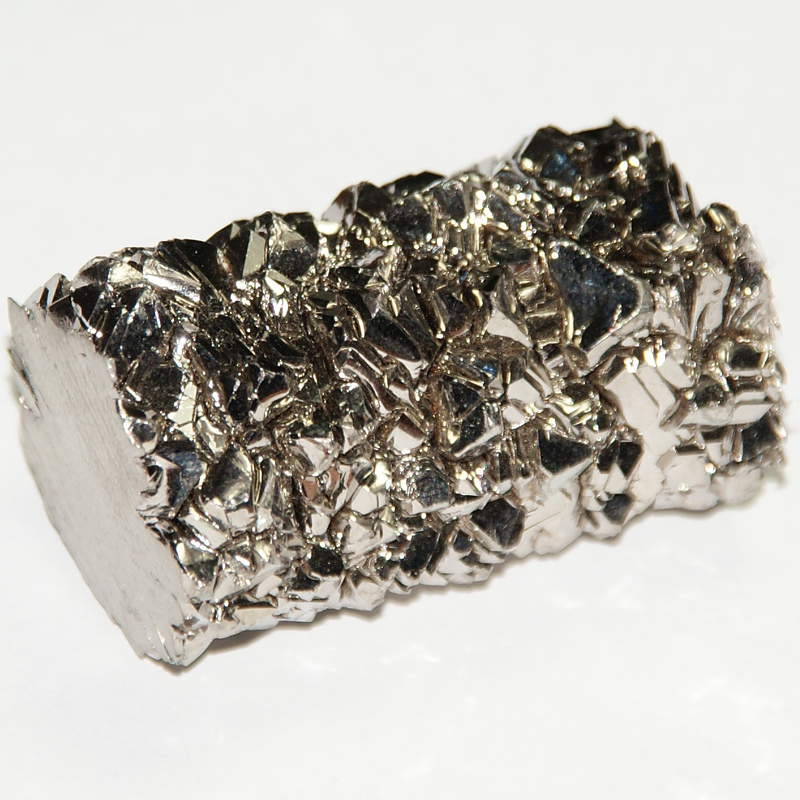发布日期:2016-5-31 15:15:07
Description:
Titanium is a strong lightweight metal often used in airplanes. When titanium combines with oxygen, it forms titanium dioxide (TiO2), a brilliant white pigment used in paint, paper, and plastics. Major deposits of titanium minerals are found in Australia, Canada, India, Norway, South Africa, Ukraine, and the United States. The sample in the photo is a mineral collector’s specimen of titanite (or sphene). However, it is not typical of the black sands often used to produce titanium metal or TiO2 pigment.
Background:
In 1791, the Reverend William Gregor, an English clergyman and mineralogist, reported that he had discovered a magnetic black sand near the beaches of Cornwall, England. The mineral was named menachanite after the local parish of Menaccan. A few years after Gregor’s discovery, M.H. Klaproth, a German chemist, separated TiO2 from the mineral rutile. Klaproth named the new element titanium after the giants of Greek mythology. In 1825, J.J. Berzelius, a Swedish chemist, performed a crude separation of titanium metal. However, it was not until 1910 that M.A. Hunter, an American chemist, produced pure titanium. W.J. Kroll patented his method for producing titanium metal in 1938. Coincidently, commercial production of titanium metal and TiO2 pigment began in the 1940s.
Titanium is a hard, silvery-gray metallic element. Its atomic number is 22 and its symbol is Ti. It is the 9th most common element in the Earth’s crust. It also is found in meteorites, the moon, and the sun.
Titanium metal has a number of useful physical properties. It is very resistant to corrosion. It is hard, has a high melting temperature, and is lightweight. Its strength is similar to steel, but is 45% lighter. Titanium alloys can be twice as strong as aluminum alloys.
Titanium has no known nutritional benefit for animals. It does, however, have some slight benefits for plant health. Titanium has been found to be very compatible with the human body and is often used in surgical instruments and medical implants. Titanium is the only element that will burn in a pure nitrogen atmosphere.
Name:
Titanium was named by M.H. Klaproth after Titans. The Titans were the giant sons of Uranus and Gaea. They set out to rule heaven, but were defeated by Zeus. Although the name seems quite appropriate, it was not meant to impart any particular meaning.
Sources:
Titanium is found in many minerals. Ilmenite (FeTiO3) and rutile (TiO2) are the most important sources of titanium. Ilmenite provides about 90% of the titanium used every year. It is estimated that the resources of ilmenite in the world contain 1 billion tons of titanium dioxide. The estimated resources of rutile in the world contain about 230 million tons of titanium dioxide. Rutile and ilmenite are extracted from sands that may contain only a few percent by weight of these minerals. After the valuable minerals are separated, the remaining sands are returned to the deposit and the land recultivated. In the United States, titanium-rich sands are mined in Florida and Virginia. Even though the United States mines and processes titanium and titanium dioxide, it still imports significant amounts of both. Metallic titanium is imported from Russia (36%), Japan (36%), Kazakhstan (25%), and other nations (3%). TiO2 pigment for paint is imported from Canada (33%), Germany (12%), France (8%), Spain (6%), and other nations (36%).
Uses:
Most titanium is used in its oxide form. TiO2 is a white pigment used in paint, varnishes and lacquers (49%), plastics (25%), paper (16%), and other products such as fabrics, printing inks, roofing granules, and special coated fabrics.
Titanium is lighter than steel but still is very strong. It also has a very high melting temperature. These physical properties make titanium and titanium alloys (an alloy is a mixture of metals) very useful in the aerospace industry where it is mostly used to make engines and structural components for airplanes, satellites, and spacecraft. An estimated 60% of metallic titanium is used in the aerospace industry. The remaining 40% is used in a number of other areas that require titanium’s unique properties.
For example, one physical property of titanium is that it is very resistant to corrosion. Since it is very resistant to corrosion by seawater, it is used to make propeller shafts and other ship parts that will be exposed to ocean water. For medial uses, titanium is considered to be bio-compatible and often is used to make joint replacement parts such as hip joints. Because of its strength, it is also used to make armor plated vehicles for the military. Titanium is also used to produce silvery-white sparks in some fireworks.
Substitutes and Alternative Sources:
There are few good substitutes for titanium for its aerospace uses. Substituting other metals for titanium usually results in alloys that are not as lightweight or as strong as titanium alloys. For applications that require corrosion resistance, titanium alloys compete with nickel, stainless steel, and zirconium alloys.
As a white pigment, TiO2’s brightness and opacity are nearly unsurpassed. However, a number of less expensive compounds can be used to substitute or reduce the amount of titanium dioxide needed. These alternative materials include calcium carbonate, the mineral talc, and the clay kaolin.





